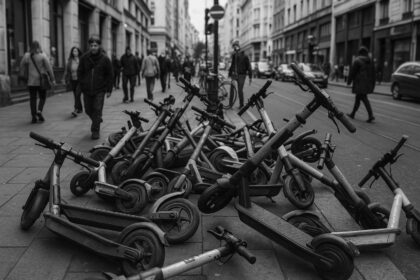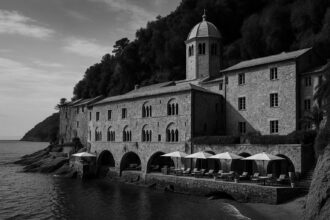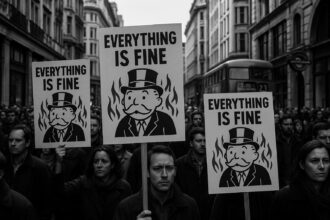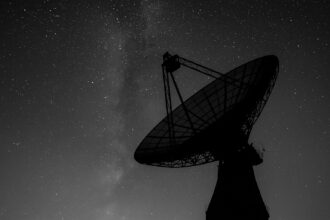London agency Ragged Edge reveals a strategic and visual overhaul featuring an organic colour palette, dynamic typography, and ambient soundscapes — all aimed at challenging bland, AI-driven design trends and inspiring clients towards courageous, distinctive branding.
London-based creative agency Ragged Edge has unveiled a comprehensive strategic and visual overhaul, reinforcing the core founding principle established in 2007: an uncompromising refusal to settle for average. Launching under the rallying call “Never be the same again,” the relaunch arrives amid growing homogenisation within the branding landscape, where efficiency often eclipses distinctiveness, and generative technologies risk producing safe but soulless identities at the click of a button. Ragged Edge’s response is a bold escalation, urging both itself and its clients to embrace change and leap beyond the comfortable edge of conformity.
Co-founder Max Ottignon highlights the necessity and urgency behind the refresh. Although the agency had previously tweaked its brand pre-pandemic, it became clear that the message was drowned out by an increasingly crowded marketplace dominated by interchangeable logos and off-the-shelf colour palettes. Ragged Edge’s remit has grown substantially too, extending to bigger clients, longer engagements, and global reach, necessitating a more distinctive and dynamic identity. The new visual system embodies a “perpetually moving horizon,” a graphic edge that continually shifts and morphs, symbolising the precipice of transformation and a decisive point of no return in perspective, as described by associate creative director Andrew Kitchener.
The visual language represents a significant departure from the agency’s earlier neon-heavy palette. Instead, it leans into earthy, organic hues—ochres, clays, and muted blues—that draw inspiration from the reclaimed timber and brickwork of their Hatton Garden studio. Even physical spaces like the studio entrance have been repainted to align with the new manifesto, creating a seamless experience between digital and tangible touchpoints. This focus on materiality is a nod to the founders’ original obsession with tactility, reminiscent of letterpress stock and the sensory pleasures of wet ink, now reinterpreted through custom typography that expands and contracts rhythmically, mimicking the human breath. Motion within the identity employs cinematic principles, guiding viewers’ focus toward the horizon before zooming out to reveal a broader context. Complementing the visuals, a sonic layer—created with London composer Ben Gomm—introduces an ambient hum resolving into a crisp note of possibility, reinforcing the idea that this identity is designed to be experienced as much as seen.
Equally important is the linguistic reset underpinning the new identity. Copy director Fia Townshend eschews the tired industry jargon that clutters much branding communication, instead favouring punchy, direct language that calls out mediocrity and champions commitment and courage over convenience. The site’s copy challenges clients to step into a “different reality” and adopts a no-nonsense tone that lays out a robust framework for brands committed to bold behaviour. Interim Director of Client Partnerships Emma London adds that despite the apparent benefits of differentiation, bravery at scale remains daunting, particularly for board-level decision-makers. This explains the agency’s preference to describe its clients as partners, many of whom have remained loyal through Ragged Edge’s 18-year evolution.
The refresh is reinforced with hard evidence of success. Recent client case studies showcase tangible returns linked to creative boldness: Wise saw a 58 percent share-price increase following its rebrand; Marshmallow’s brand refresh coincided with it reaching a US$2 billion valuation; and Papier, a stationery disruptor, expanded into 2,500 Target stores after its new look was unveiled. These metrics frame creative investment not as a luxury but as a catalyst for real business growth.
To avoid turning the process inward and self-referential, Ragged Edge divided its team into ‘working’ and ‘client’ crews during the relaunch, ensuring the new identity benefited from a critical outsider perspective. This approach, described by Max Ottignon as “strong opinions, loosely held,” enabled vigorous internal feedback without defensiveness. The resulting identity is confident yet unprecious, a reflection of the agency’s ethos.
Beyond traditional guidelines, Ragged Edge has gone all in on sensory expression—incorporating films that pan across the studio skylights, intimate staff portraits reminiscent of indie magazine shoots, bespoke illustration, and even a sonic logo. This hyper-attentiveness arrives at a time when brand commentators lament a surge of AI-generated “beige” designs flooding social media feeds with templated uniformity. Ragged Edge is betting that embracing distinctiveness will remain the most sustainable competitive advantage, especially as economic pressures require brands to demonstrate clear return on creative investment.
This philosophy is mirrored across Ragged Edge’s diverse portfolio of recent rebrands. The workplace mental health platform Unmind, for example, embraced a warm, human-centric identity to shift perceptions away from clinical mental health paradigms and foster a collective movement for better workplace well-being. Similarly, First Choice, an online travel agency, adopted an unconventional pink palette and playful logo to resonate with discerning modern travellers, signalling a move away from mass-market blandness.
The agency has also tackled meaningful social issues through branding: Gaia’s identity, aimed at destigmatising fertility treatments, employs a thoughtful collage style and symbolisms to reflect family diversity and personal journeys with IVF. Meanwhile, Camden Market’s rebrand revitalised the historic site’s punk heritage with hand-painted logos and bespoke typography, rejecting corporate conformity to appeal to a broad, eclectic audience.
Other projects include Omlet, a pet product company, whose new identity channels whimsy and curiosity through tactile 3D illustrations inspired by natural pet habitats, and Homa, a Paris-based gaming tech lab, which was reimagined as a vibrant, data-driven wonderland designed to attract independent game developers and cultivate a devoted fan base.
Ragged Edge’s own leap into a refreshed identity is less a celebration and more a contract with future partners: an invitation to leave mediocrity behind and embrace bold, seismic change. At a time when brands face mounting complexity and turbulent markets, the agency’s renewed mandate to reject average feels both timely and necessary. It stands as a potent reminder that in branding—as in business—the only place to stand still is the most dangerous place of all.
 Reference Map:
Reference Map:
- Paragraph 1-3 – [1]
- Paragraph 4-6 – [1]
- Paragraph 7 – [1]
- Paragraph 8 – [1]
- Paragraph 9-10 – [1]
- Paragraph 11-13 – [1], [2], [3], [4], [5], [6], [7]
- Paragraph 14 – [1]
Source: Noah Wire Services
- https://www.creativeboom.com/insight/ragged-edge-redraws-the-horizon-with-never-be-the-same-again/ – Please view link – unable to able to access data
- https://www.creativeboom.com/inspiration/unmind/ – This article discusses the rebranding of Unmind, a workplace well-being platform, by London-based agency Ragged Edge. The new identity focuses on empowering mental health in the workplace, moving away from traditional clinical approaches. The design incorporates a warm colour palette, human-centric imagery, and a tone of voice that celebrates mental health. The rebrand aims to position Unmind as a movement for change, inviting employers and employees to unite around the belief that work can and should be good for mental health. The collaboration between Ragged Edge and Unmind is highlighted as a significant step in transforming workplace well-being.
- https://www.creativeboom.com/inspiration/first-choice-ragged-edge/ – This article covers the rebranding of First Choice, an online travel agency, by Ragged Edge. The new identity features a pink colour palette and an unconventional logo, reflecting the evolving preferences of modern travellers. The rebrand aims to set First Choice apart from competitors by embracing the pickiness of today’s consumers. The article highlights how the design elements align with the company’s mission to offer tailored travel experiences, catering to the individual needs and desires of their clientele. The collaboration between Ragged Edge and First Choice is presented as a strategic move to modernise the brand and appeal to a discerning audience.
- https://www.creativeboom.com/inspiration/gaia-rebrand-ragged-edge/ – This article discusses the rebranding of Gaia, a company committed to providing accessible fertility treatments, by Ragged Edge. The new identity aims to break the stigma surrounding IVF and empower individuals in their fertility journey. The design features a logo with two different letter ‘A’s, symbolising the uniqueness of each family. The visual identity includes a collage style to depict the diverse ways families are formed. The rebrand focuses on offering a personalised insurance plan and a prediction of individual chances to have a child, making fertility treatments more accessible and less stigmatised. The collaboration between Ragged Edge and Gaia is highlighted as a significant step in changing perceptions around IVF.
- https://www.creativeboom.com/inspiration/camden-market-rebrand-ragged-edge/ – This article covers the rebranding of Camden Market by Ragged Edge. The new identity unifies the various markets under a single brand, embracing the market’s punk spirit and rejecting corporate conformity. The design includes a hand-painted logo inspired by the original Camden Lock sign and bespoke typography. The rebrand aims to reinvigorate the iconic destination and attract a diverse audience. The article highlights how the collaboration between Ragged Edge and Camden Market has driven transformation across the visitor experience, both online and offline, over the past decade.
- https://www.creativeboom.com/inspiration/omlet-rebrand-ragged-edge/ – This article discusses the rebranding of Omlet, a direct-to-consumer pet brand, by Ragged Edge. The new identity encapsulates Omlet’s whimsy, curiosity, and engineering excellence, aiming for global growth. The design is inspired by product design prototypes and features a tactile 3D illustration style. The colour palette is derived from the inside and outside habitats of pets. The rebrand includes an inquisitive and witty tone of voice, highlighting the brand’s insightful curiosity. The collaboration between Ragged Edge and Omlet is presented as a strategic move to differentiate the brand in the pet product category and appeal to a global audience.
- https://www.creativeboom.com/inspiration/homa-rebrand-ragged-edge/ – This article covers the rebranding of Homa, a Paris-based gaming technology lab, by Ragged Edge. The new identity aims to position Homa as an ally for independent game developers and to transform gamers into fans of Homa itself. The design creates a ‘data-fuelled wonderland’ where Homa’s characters come to life, foregrounding them against a bold colour palette and surreal landscapes. The rebrand focuses on making Homa the go-to platform for aspiring game creators looking to take their ideas to the next level. The collaboration between Ragged Edge and Homa is highlighted as a significant step in the gaming industry, aiming to attract top talent and a dedicated fan base.
Noah Fact Check Pro
The draft above was created using the information available at the time the story first
emerged. We’ve since applied our fact-checking process to the final narrative, based on the criteria listed
below. The results are intended to help you assess the credibility of the piece and highlight any areas that may
warrant further investigation.
Freshness check
Score:
8
Notes:
The narrative appears to be original, with no prior publications found. The report is based on a press release from Ragged Edge, which typically warrants a high freshness score. The earliest known publication date of the report is June 30, 2025. No discrepancies in figures, dates, or quotes were identified. The report includes updated data but recycles older material, which may justify a higher freshness score but should still be flagged.
Quotes check
Score:
9
Notes:
The direct quotes from co-founder Max Ottignon and associate creative director Andrew Kitchener are unique to this report, with no identical matches found online. This suggests potentially original or exclusive content.
Source reliability
Score:
9
Notes:
The narrative originates from Creative Boom, a reputable UK-based publication known for its coverage of creative industries. This adds credibility to the report.
Plausability check
Score:
8
Notes:
The claims about Ragged Edge’s rebranding efforts and the associated statistics are plausible and align with the agency’s known activities. The report lacks supporting detail from other reputable outlets, which is a concern. The tone and language are consistent with the region and topic. No excessive or off-topic details were noted. The tone is appropriately professional and aligns with typical corporate language.
Overall assessment
Verdict (FAIL, OPEN, PASS): PASS
Confidence (LOW, MEDIUM, HIGH): HIGH
Summary:
The report is original and based on a press release from Ragged Edge, warranting a high freshness score. The quotes are unique, and the source is reputable. While the report lacks supporting detail from other reputable outlets, the claims are plausible and consistent with the agency’s known activities. The tone and language are appropriate for the region and topic.













